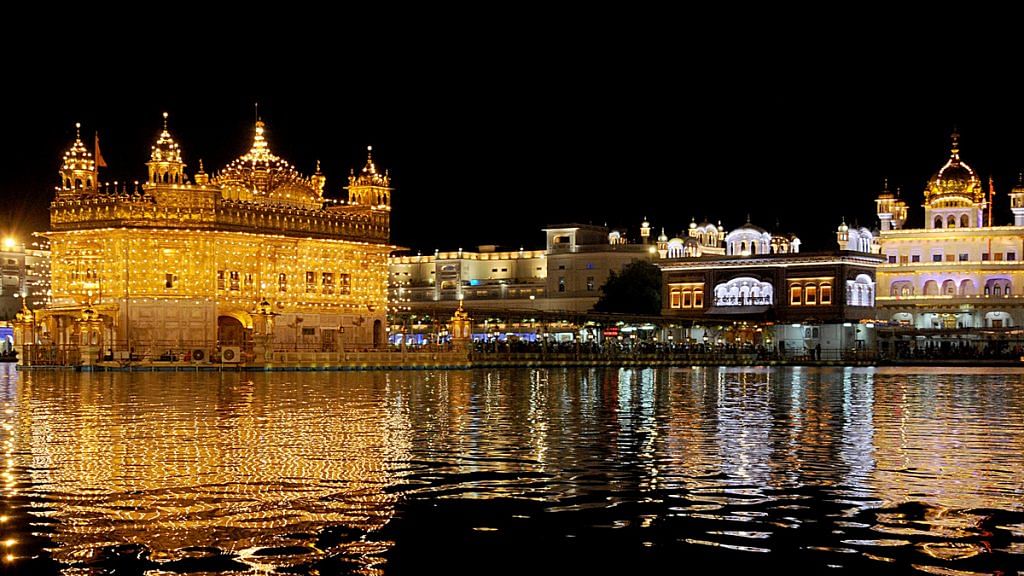In the year 1606, the fifth Sikh guru, Guru Arjan Dev, was captured by Mughal Emperor Jahangir and imprisoned in Lahore Fort. Part of the reason was the fact that he had blessed Jahangir’s rebellious son Khusrau, and part because of his growing influence in Northern India and fast conversions to Sikhism that threatened the orthodox Muslim clergy as well as the Hindu elite.
After imprisoning the guru, Jahangir demanded Rs 2 lakh as a fine plus elimination of all texts from the Adi Granth, the Sikh holy book the guru had compiled, that could be ‘offensive’ to Hindus or Muslims.
But the guru was unrelenting and refused to omit anything from the Granth, so the Mughal emperor condemned him to be tortured to death. Famously, the guru was made to sit on a burning hot plate, hot sand poured on his face. It is said that when he was allowed to take a bath in River Ravi on 30 May 1606, he never returned. It is here that Gurdwara Dera Sahib in Lahore stands.
On Guru Arjan Dev’s 457th birth anniversary, here is a look at his influence on Sikhism.
Also read: The religious and historical significance of Kartarpur Sahib gurudwara
The making of Harmandir Sahib
Born on 15 April 1563 to Guru Ramdas and Bibi Bhani, Arjan Dev was chosen by his father as his successor even though he was the youngest son. The decision may have led to disputes, but what is undisputed is the fifth guru’s legacy.
One of the most visible, tangible and iconic contributions of Guru Arjan Dev is that he was the one who conceived of and began the construction of Harmandir Sahib, or the Golden Temple, in Amritsar.
Arjan Dev wanted Harmandir Sahib to stand for inclusivity, a place where everyone was welcome. It is on these values that he designed the temple, which has four entries and exits denoting acceptance of the 4 Hindu castes and all religions.
The guru also invited the renowned Muslim saint Mia Mir to lay the foundation stone of the temple. Instead of making the temple a towering elevated monument, he decided to place it at a lower elevation as a symbolic gesture, so that one would feel humble upon entering the temple.
Also read: Zafarnama, the ‘victory letter’ that Guru Gobind Singh wrote to Aurangzeb
The Adi Granth
Guru Arjan Dev is credited with compiling the Adi Granth which was completed in 1604. It is a compilation of the hymns composed by Guru Nanak and 32 other Hindu and Muslim saints including more than 2,000 hymns that he composed himself. This included works of Sheikh Farid, Bhagat Kabir, Bhagat Ravi Das, Dhanna Namdev, Ramannand, Jai Dev, Trilochan, Beni, Pipa, and Surdas.
The Adi Granth was later declared as the ultimate Guru Bani or word of god by Guru Gobind Singh. He added 115 hymns composed by Guru Tegh Bahadur in the second rendition and the Adi Granth became the Guru Granth Sahib.
The first copy of the Adi Granth is kept in Kartarpur at Gurdwara Thum Sahib.
Also read: Guru Tegh Bahadur — the ninth Sikh guru who sacrificed himself for religious freedom
Influence on Sikhism
Even though Guru Arjan Dev played a vital role in completing the Adi Granth and Harmandir Sahib, two of the holiest and strongest symbols of Sikhs, it’s in his death that his influence on the religion is strongest.
Before he was summoned to Lahore by Jahangir where he was captured and later executed, Arjan Dev had appointed his son Hargobind as his successor.
When Guru Hargobind took the throne, he was the first Sikh guru to deviate from the poet-guru tradition established since Guru Nanak. Armed with two swords dangling by his waist, Hargobind changed the identity of the Sikh guru who was here to save the Sikhs from oppression by the Mughals. The sacrifice of Guru Arjan Dev was looked at as a sacrifice for the truth, and it became un-Sikh like to stand oppression. The guru’s death became a watershed moment as from then on began the militarisation of Sikhs.
This conflict that started between the Mughals and Sikhs with the execution of Arjan Dev continued till the last guru, Gobind Singh who finally established the militarised order, the Khalsa, in 1699.
Also read: Who are Nihang Sikhs? ‘Guru di laadli fauj’ warrior sect in news for chopping off cop’s hand
